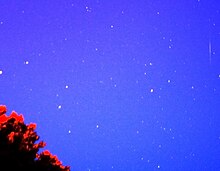Quadrantids
|
Meteor shower quadrantids |
|
|---|---|
| activity | |
| Beginning | December 28th |
| maximum | January 4th |
| The End | January 12th |
| Radian position | |
| RA | 15 h 20 m |
| DE | + 49 ° |
| ZHR | 110 (60-190) |
| Population index | 2.1 |
| geocentric speed |
41 km / s |
The Quadrantids are a meteor shower that recurs annually at the turn of the year . It is one of the four most active shooting star swarms.
Their radiant (apparent origin) lies in the northeastern part of the constellation Bear Guardian (Latin: boats), which is why they are also called bootids . The name Quadrantiden comes from the former constellation Wall Quadrant , which is no longer officially listed and was located between the boat, dragon and Hercules .
The quadrantids occur in the first week of January, with a sharp maximum in the night from January 3rd to 4th - but this only lasts a few hours. Under ideal conditions, up to 110 meteors per hour can be observed, in some years even 200. However, the average brightness of the meteors is low (3rd to 6th magnitude ), their speed is around 40 km / s.
The radiant is circumpolar , but in the evening it is still close to the horizon, so that only a few shooting stars can be seen. From midnight to the beginning of dawn, however, the radian rises from 30 ° to 70 to 80 ° altitude, which greatly increases the proportion of observable meteors.
Maternal body and railway disorders
The meteor shower was discovered in Italy in 1825 and in Switzerland in 1835. A higher fall rate of 60 per hour was first observed in England in 1864, but dropped to 10 the next day. The fact that the maximum only lasts a few hours, but in some years is over 200 / h, has only been confirmed in the last few decades.
Until a few years ago it was not known which mother body produced the Quadrantids. On March 6, 2003, the asteroid 2003 EH 1 was discovered, the orbit parameters of which agree well with those of the Quadrantids. According to an article by meteor expert Peter Jenniskens , 2003 EH 1 is the inactive remnant of what was once a much larger cometary nucleus that fell apart, with 2003 EH 1 and the quadrantids being said to have formed. A candidate for the comet of origin is the C / 1490 Y1 observed 500 years ago in China , whose orbital elements also match the quadrantids. The presumably young age of the meteor shower also supports this hypothesis .
Apparently the particles concentrate on only short areas of the elliptical orbit, which is also influenced by the planet Jupiter . As a result, the annual maximum fluctuates strongly ( ZHR between about 60 and 190). In addition, in 1918 the radian was shifted by a few degrees. In about 300 years, the orbital ellipse should no longer intersect the earth's orbit and the quadrantids will become unobservable.
The Draconid meteor shower that occurs in October , whose comet 21P / Giacobini-Zinner also belongs to the Jupiter family, has a similar orbit . Their radians are only 20 ° away in the head of the constellation Dragon .
Web links
- Quadrantid. In: meteorshowersonline.com (English)
- 2003 EH 1 is the Quadrantid shower parent comet. In: ephemeris.sjaa.net (English)
- Quadrantids. In: astrocorner.de (German)
- Mother body discovered for falling stars. In: astronews.com (German)
- General information, history & links. In: leoniden.net (German)
- Meteors in January 2018 - Moon vs. Counting shooting stars
Individual evidence
- ↑ IMO Meteor Shower Calendar 2019. In: imo.net , accessed on June 19, 2019
